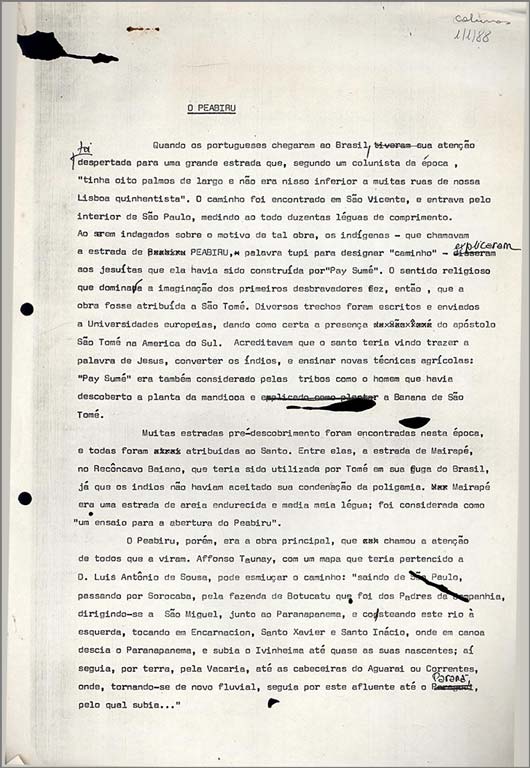

Original title: O Peabiru. Pdf, 3 pages.
Quando os portugueses chegaram ao Brasil, sua atenção foi despertada para uma grande estrada que, segundo um colunista da época, “tinha oito palmos de largo e não era nisso inferior a muitas ruas de nossa Lisboa quinhentista”. O caminho foi encontrado em São Vicente, e entrava pelo interior de São Paulo, medindo ao todo duzentas léguas de comprimento.
Ao serem indagados sobre o motivo de tal obra, os indígenas – que chamavam a estrada de PEABIRU, palavra tupi para designar “caminho” – explicaram aos jesuítas que ela havia sido construída por “Pay Sumé”. O sentido religioso que dominava a imaginação dos primeiros desbravadores fez, então, que a obra fosse atribuída a São Tomé. Diversos trechos foram escritos e enviados a Universidades europeias, dando como certa a presença do apostolo São Tomé na America do Sul. Acreditavam que o santo teria vindo trazer a palavra de Jesus, converter os índios, e ensinar novas técnicas agrícolas: “Pay Sumé” era também considerado pelas tribos como o homem que havia descoberto a planta de mandioca a banana de São Tomé.
When the Portuguese arrived in Brazil, their attention was drawn to a large road that, according to a columnist of the time, “was eight feet wide and was not inferior to many streets in our 16th century Lisbon”. The path was found in São Vicente, and led to the center of São Paulo, spanning two hundred leagues in length.
When asked about the reason for such work, the indigenous people – who called the road PEABIRU, a Tupi word for “way” – explained to the Jesuits that it had been built by “Pay Sumé”. The religious sense that dominated the imagination of the first explorers, then, caused the work to be attributed to São Tomé. Several passages were written and sent to European Universities, taking for granted the presence of the apostle São Tomé in South America. They believed that the saint would have come to bring the word of Jesus, convert the Indians, and teach new agricultural techniques: “Pay Sumé” was also considered by the tribes as the man who had discovered the banana cassava plant de São Tomé.

 Back To Top
Back To Top